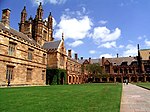The University of Sydney Nano Institute
| Established | March 2016 |
|---|---|
| Faculty | University of Sydney |
| Formerly called | Australian Institute for Nanoscale Science and Technology (AINST) |
| Location | Sydney, Australia |
| Website | http://sydney.edu.au/nano |
The University of Sydney Nano Institute (Sydney Nano) is a multidisciplinary research institute at the University of Sydney in Camperdown, Sydney, Australia. It focuses on multidisciplinary research in nanoscale science and technology. It is one of ten multidisciplinary research institutes at the University of Sydney, along with the Charles Perkins Centre and the Brain and Mind Centre.
Location and facilities[edit]
Sydney Nano is headquartered at the Sydney Nanoscience Hub. It was built for nanoscience research and opened in 2015 on the University of Sydney's Camperdown/Darlington campus.
History[edit]
Sydney Nano was originally launched in April 2016,[1] as the Australian Institute for Nanoscale Science and Technology (AINST). The institute was renamed The University of Sydney Nano Institute in November 2017.[2][3]
In July 2017, the University of Sydney announced a multi-year partnership with Microsoft to conduct research into quantum computing and the official establishment of Microsoft Quantum - Sydney at the Sydney Nanoscience Hub.[4][5][6]
In March 2018, the New South Wales Government provided a A$500,000 grant[7] to set up the Sydney Quantum Academy to strengthen postgraduate research and training in quantum computing. The academy is led by the University of Sydney in partnership with Macquarie University, the University of New South Wales and the University of Technology, Sydney.
Directors[edit]
Sydney Nano was jointly led by three interim directors, Thomas Maschmeyer, Simon Ringer, and Zdenka Kuncic, who oversaw the launch period of the institute from March 2016.
Susan Pond was appointed to the directorship in February 2017, for a period of 12 months.
Ben Eggleton served as director from May 2018[8] to December 2022, when Alice Motion was appointed interim director for six months.[9]
References[edit]
- ^ Strom, Marcus (8 March 2016). "Sydney University to open Nanoscience Hub for the quantum technologies of the future". The Sydney Morning Herald. Archived from the original on 20 March 2018. Retrieved 20 March 2018.
- ^ "High Wired Update: Nano by name and by nature". www.theaustralian.com.au. Retrieved 20 March 2018.
- ^ "Small changes mean big opportunities: AINST becomes Sydney Nano". The University of Sydney. Archived from the original on 20 March 2018. Retrieved 27 November 2017.
- ^ "Microsoft and University of Sydney forge quantum partnership". The University of Sydney. Archived from the original on 2 September 2017. Retrieved 27 November 2017.
- ^ "USYD and Microsoft sign global quantum computing partnership – PACE". PACE. 25 July 2017. Archived from the original on 26 July 2017. Retrieved 20 March 2018.
- ^ "Sydney nanoscience centre opens doors for Microsoft to lead 'computer arms race'". ABC News. 20 April 2016. Archived from the original on 21 March 2017. Retrieved 20 March 2018.
- ^ Pash, Chris (7 March 2018). "Sydney just entered the race to build the world's first quantum computer". Business Insider Australia. Archived from the original on 20 March 2018. Retrieved 20 March 2018.
- ^ "Professor Ben Eggleton appointed director of Sydney Nano". The University of Sydney. 10 April 2018. Retrieved 7 November 2018.
- ^ "Alice Motion appointed interim Sydney Nano Director". The University of Sydney. Retrieved 8 December 2022.

